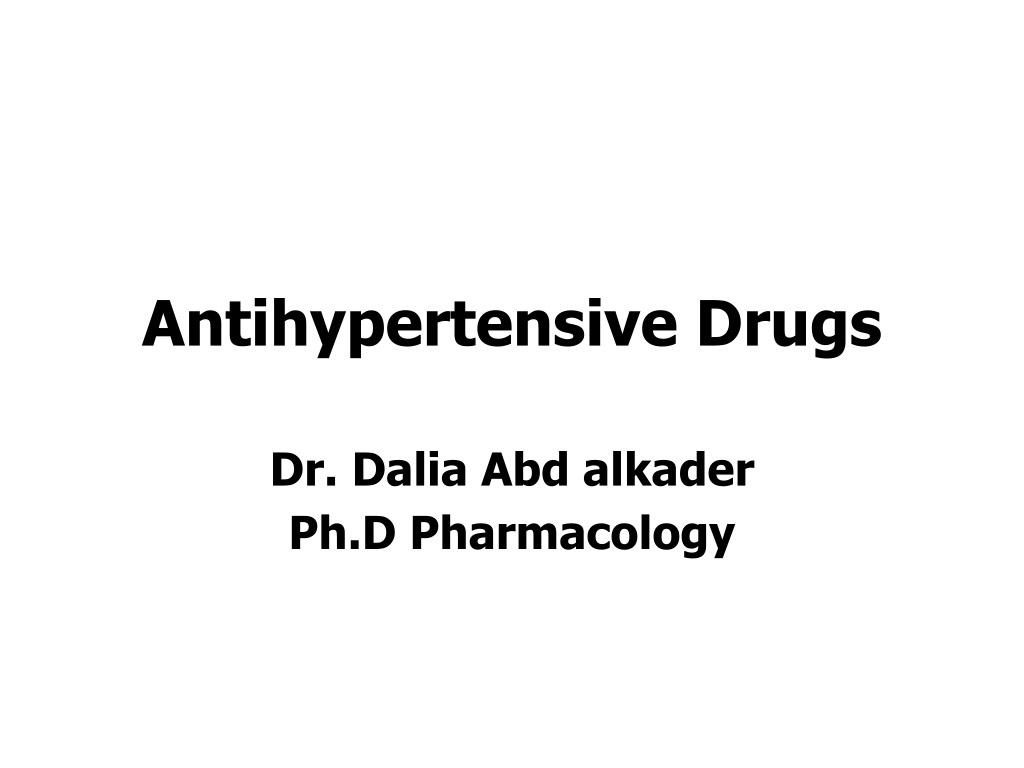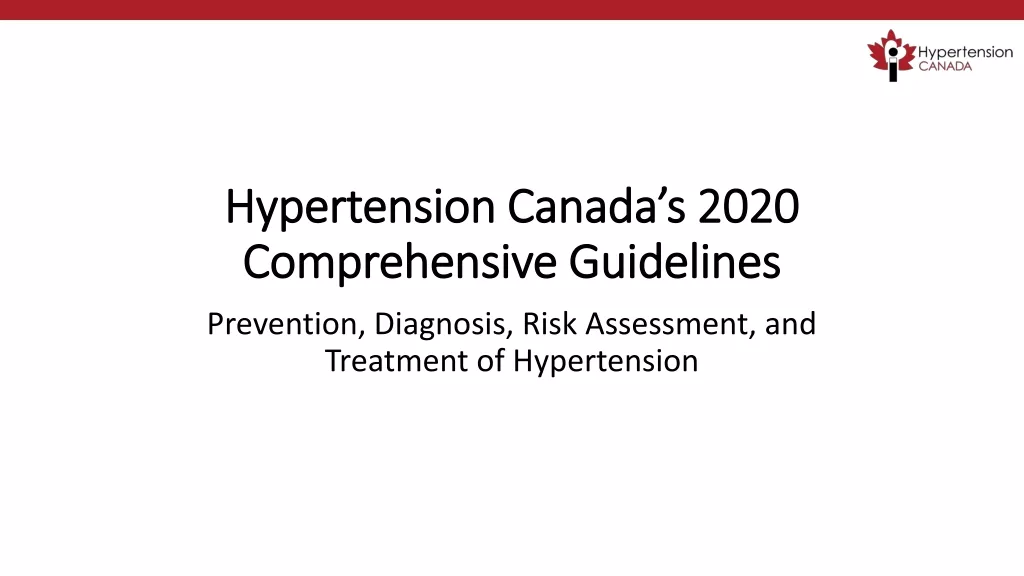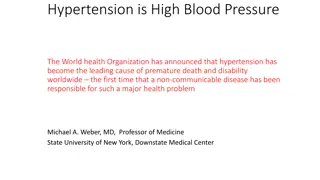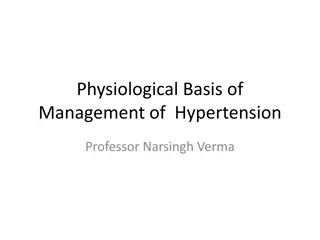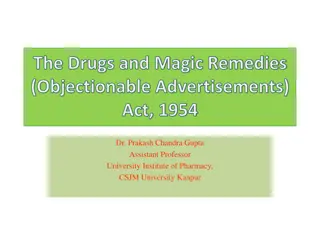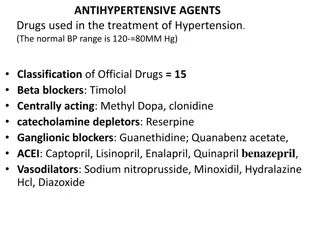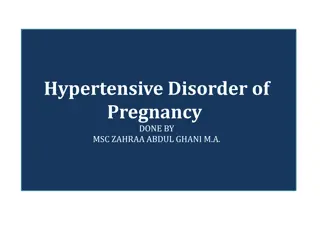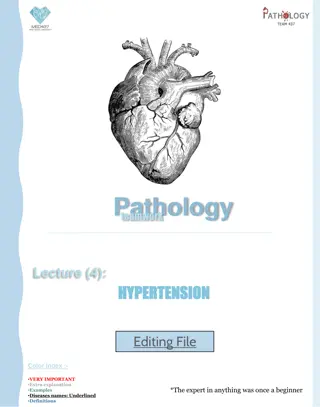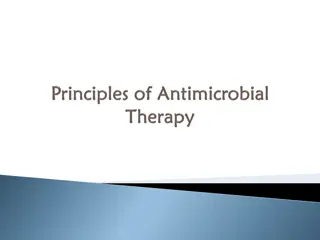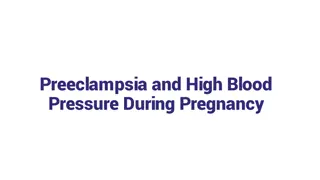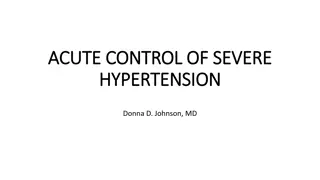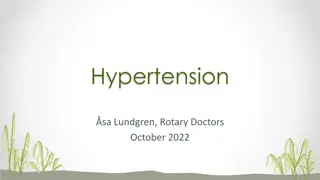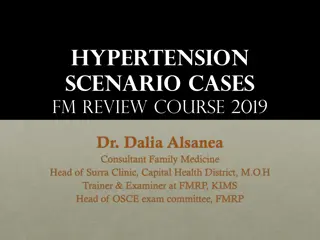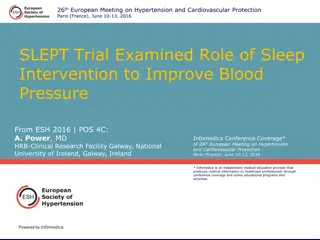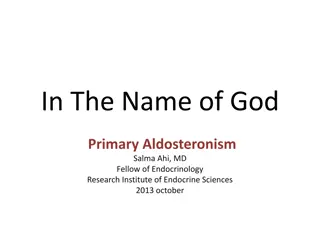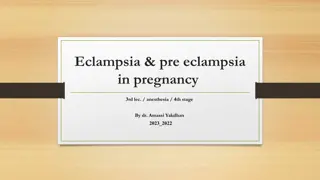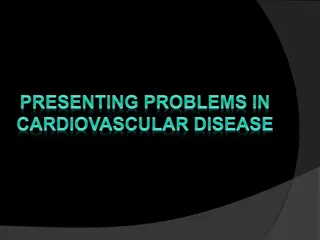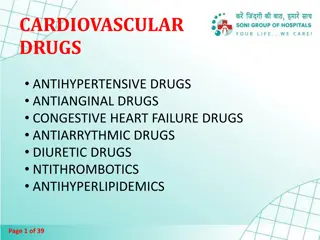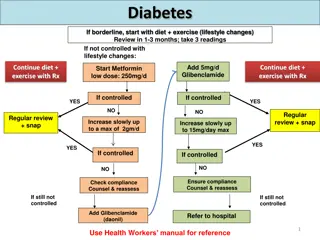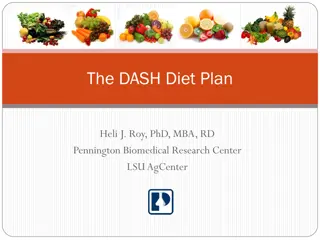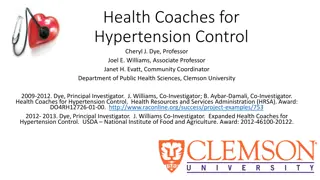Hypertension and Antihypertensive Drugs
Hypertension, characterized by high blood pressure, can lead to serious health issues if left untreated. Essential hypertension is common, with various risk factors such as family history and lifestyle choices contributing to its development. Antihypertensive drugs play a crucial role in managing blood pressure by affecting cardiac output and vascular resistance. Awareness, early diagnosis, and proper treatment are key to reducing the morbidity and mortality associated with hypertension.
Download Presentation

Please find below an Image/Link to download the presentation.
The content on the website is provided AS IS for your information and personal use only. It may not be sold, licensed, or shared on other websites without obtaining consent from the author.If you encounter any issues during the download, it is possible that the publisher has removed the file from their server.
You are allowed to download the files provided on this website for personal or commercial use, subject to the condition that they are used lawfully. All files are the property of their respective owners.
The content on the website is provided AS IS for your information and personal use only. It may not be sold, licensed, or shared on other websites without obtaining consent from the author.
E N D
Presentation Transcript
Antihypertensive Drugs Dr. Dalia Abd alkader Ph.D Pharmacology
Hypertension is defined as either a sustained systolic blood pressure of greater than 140 mm Hg or a sustained diastolic blood pressure of greater than 90 mm Hg. Hypertension results from increased arteriolar resistance and reduced capacitance of the venous system.
Although many patients have no symptoms, chronic hypertension can lead to heart disease and stroke, the top two causes of death in the world. Hypertension is also an important risk factor in the development of chronic kidney disease and heart failure. The incidence of morbidity and mortality significantly decreases when hypertension is diagnosed early and is properly treated.
ETIOLOGY OF HYPERTENSION Although hypertension may occur secondary to other disease processes, more than 90% of patients have essential hypertension (hypertension with no identifiable cause). A family history of hypertension. The prevalence of hypertension increases with age, but decreases with education and income level.
Non-Hispanic blacks have a higher incidence of hypertension than do both non-Hispanic whites and Hispanic whites. Persons with diabetes, obesity, or disability status are all more likely to have hypertension than those without. Environmental factors, such as a stressful lifestyle, high dietary intake of sodium, and smoking, may further predispose an individual to hypertension.
MECHANISMS FOR CONTROLLING BLOOD PRESSURE Arterial blood pressure is directly proportional to cardiac output and peripheral vascular resistance. Most antihypertensive drugs lower blood pressure by reducing cardiac output and/or decreasing peripheral resistance. Cardiac output and peripheral resistance, in turn, are controlled mainly by two overlapping control mechanisms: the baroreflexes and the renin angiotensin aldosterone system .
Response of the autonomic nervous system and the reninangiotensin aldosterone system to a decrease in blood pressure
A. Baroreceptors and the sympathetic nervous system Baroreflexes act by changing the activity of the sympathetic nervous system. Therefore, they are responsible for the rapid, moment-to moment regulation of blood pressure. A fall in blood pressure causes pressure- sensitive neurons (baroreceptors in the aortic arch and carotid sinuses) to send fewer impulses to cardiovascular centers in the spinal cord.
This prompts a reflex response of increased sympathetic and decreased parasympathetic output to the heart and vasculature, resulting in vasoconstriction and increased cardiac output. These changes result in a compensatory rise in blood pressure.
B. Reninangiotensinaldosterone system The kidney provides long-term control of blood pressure by altering the blood volume. Baroreceptors in the kidney respond to reduced arterial pressure (and to sympathetic stimulation of 1- adrenoceptors) by releasing the enzyme renin.
Low sodium intake and greater sodium loss also increase renin release. Renin converts angiotensinogen to angiotensin I, which is converted in turn to angiotensin II, in the presence of angiotensin-converting enzyme (ACE). Angiotensin II is a potent circulating vasoconstrictor, constricting both arterioles and veins, resulting in an increase in blood pressure.
Angiotensin II exerts a vasoconstrictor action on the efferent arterioles of the renal glomerulus, increasing glomerular filtration. angiotensin II stimulates aldosterone secretion, leading to increased renal sodium reabsorption and increased blood volume, which contribute to a further increase in blood pressure. These effects of angiotensin II are mediated by stimulation of angiotensin II type 1 (AT1) receptors.
TREATMENT STRATEGIES The goal of antihypertensive therapy is to reduce cardiovascular and renal morbidity and mortality. The blood pressure goal when treating hypertension is a systolic blood pressure of less than 140 mm Hg and a diastolic blood pressure of less than 90 mm Hg. Mild hypertension can sometimes be controlled with monotherapy Current recommendations are to initiate therapy with a thiazide diuretic, ACE inhibitor, angiotensin receptor blocker (ARB), or calcium channel blocker
If blood pressure is inadequately controlled, a second drug should be added, with the selection based on minimizing the adverse effects of the combined regimen and achieving goal blood pressure. Patients with systolic blood pressure greater than 160 mm Hg or diastolic blood pressure greater than 100 mm Hg (or systolic blood pressure greater than 20 mm Hg above goal or diastolic blood pressure more than 10 mm Hg above goal) should be started on two antihypertensives.
A. Individualized care Hypertension may coexist with other diseases that can be aggravated by some of the antihypertensive drugs or that may benefit from the use of some antihypertensive drugs independent of blood pressure control. In such cases, it is important to match antihypertensive drugs to the particular patient.
In addition to the choice of therapy, blood pressure goals may also be individualized based on concurrent disease states. For instance, in patients with diabetes, some experts recommend a blood pressure goal of less than 140/80 mm Hg. Likewise, in patients with chronic kidney disease and proteinuria, lower goals of less than 130/80 mm Hg may be considered. Elderly patients may have less rigid goals (for example, less than 150/90 mm Hg).
Treatment of hypertension in patients with concomitant diseases. [Note: Angiotensin receptor blockers (ARBs) are an alternative to angiotensin- converting enzyme (ACE) inhibitors.]
B. Patient compliance in antihypertensive therapy Lack of patient compliance is the most common reason for failure of antihypertensive therapy. The hypertensive patient is usually asymptomatic and is diagnosed by routine screening before the occurrence of overt end- organ damage. It is important to enhance compliance by selecting a drug regimen that reduces adverse effects and also minimizes the number of doses required daily. Combining two drug classes in a single pill, at a fixed-dose combination, has been shown to improve patient compliance and the number of patients achieving goal blood pressure.
DIURETICS Thiazide diuretics can be used as initial drug therapy for hypertension The initial mechanism of action of diuretics is based upon decreasing blood volume, which ultimately leads to decreased blood pressure. Low-dose diuretic therapy is safe, inexpensive, and effective in preventing stroke, myocardial infarction, and heart failure. Routine serum electrolyte monitoring should be done for all patients receiving diuretics.
A. Thiazide diuretics hydrochlorothiazide and chlorthalidone lower blood pressure initially by increasing sodium and water excretion. useful in combination therapy with a variety of other antihypertensive agents, including -blockers, ACE inhibitors, ARBs, and potassium-sparing diuretics. With the exception of metolazone , thiazide diuretics are not effective in patients with inadequate kidney function. Loop diuretics may be required in these patients. can induce hypokalemia, hyperuricemia and, to a lesser extent, hyperglycemia in some patients.
B. Loop diuretics furosemide, torsemide, bumetanide, and ethacrynic acid act by blocking sodium and chloride reabsorption in the kidneys, even in patients with poor renal function or those who have not responded to thiazide diuretics. cause decreased renal vascular resistance and increased renal blood flow.
Like thiazides, they can cause hypokalemia. However, unlike thiazides, loop diuretics increase the Ca2+ content of urine, whereas thiazide diuretics decrease it. These agents are rarely used alone to treat hypertension, but they are commonly used to manage symptoms of heart failure and edema.
C. Potassium-sparing diuretics Amiloride and triamterene (inhibitors of epithelial sodium transport at the late distal and collecting ducts) spironolactone and eplerenone (aldosterone receptor antagonists) reduce potassium loss in the urine. Aldosterone antagonists have the additional benefit of diminishing the cardiac remodeling that occurs in heart failure. Potassium-sparing diuretics are sometimes used in combination with loop diuretics and thiazides to reduce the amount of potassium loss induced by these diuretics.
-ADRENOCEPTORBLOCKING AGENTS are a treatment option for hypertensive patients with concomitant heart disease or heart failure . Actions reduce blood pressure primarily by: decreasing cardiac output decrease sympathetic outflow from the CNS inhibit release of renin from the kidneys, thus decreasing the formation of angiotensin II and the secretion of aldosterone.
The prototype -blocker is propranolol, which acts at both 1 and 2 receptors. Selective blockers of 1 receptors, such as metoprolol and atenolol , are among the most commonly prescribed -blockers. Nebivolol is a selective blocker of 1 receptors, which also increases the production of nitric oxide, leading to vasodilation.
The selective -blockers may be administered cautiously to hypertensive patients who also have asthma. The nonselective -blockers, such as propranolol and nadolol, are contraindicated in patients with asthma due to their blockade of 2-mediated bronchodilation. -Blockers should be used cautiously in the treatment of patients with acute heart failure or peripheral vascular disease.
Therapeutic uses hypertensive patients with concomitant heart disease, such as supraventricular tachyarrhythmia (for example, atrial fibrillation), previous myocardial infarction, angina pectoris, and chronic heart failure. Conditions that discourage the use of - blockers include reversible bronchospastic disease such as asthma, second- and third- degree heart block, and severe peripheral vascular disease.
Pharmacokinetics orally active. Propranolol undergoes extensive and highly variable first-pass metabolism. Oral -blockers may take several weeks to develop their full effects. Esmolol, metoprolol, and propranolol are available in intravenous formulations.
Adverse effects 1.Common effects: bradycardia, hypotension, and CNS side effects such as fatigue, lethargy, and insomnia. The -blockers may decrease libido and cause erectile dysfunction, which can severely reduce patient compliance. 2. Alterations in serum lipid patterns: Noncardioselective - blockers may disturb lipid metabolism, decreasing high- density lipoprotein cholesterol and increasing triglycerides. 3. Drug withdrawal: Abrupt withdrawal may induce angina, myocardial infarction, and even sudden death in patients with ischemic heart disease. Therefore, these drugs must be tapered over a few weeks in patients with hypertension and ischemic heart disease.
ACE INHIBITORS Enalapril and lisinopril are recommended as first-line treatment of hypertension in patients with high coronary disease risk or history of diabetes, stroke, heart failure, myocardial infarction, or chronic kidney disease.
Actions The ACE inhibitors lower blood pressure by reducing peripheral vascular resistance without reflexively increasing cardiac output, heart rate, or contractility. These drugs block the enzyme ACE which cleaves angiotensin I to form the potent vasoconstrictor angiotensin II.
ACE is responsible for the breakdown of bradykinin, (a peptide that increases the production of nitric oxide and prostacyclin by the blood vessels). Both nitric oxide and prostacyclin are potent vasodilators. ACE inhibitors decrease angiotensin II and increase bradykinin levels. Vasodilation of both arterioles and veins occurs as a result of : decreased vasoconstriction (from diminished levels of angiotensin II) enhanced vasodilation (from increased bradykinin). By reducing circulating angiotensin II levels, ACE inhibitors also decrease the secretion of aldosterone, resulting in decreased sodium and water retention.
Effects of various drug classes on the renin angiotensin aldosterone system.
Therapeutic uses: slow the progression of diabetic nephropathy and decrease albuminuria . Beneficial effects on renal function may result from decreasing intraglomerular pressures, due to efferent arteriolar vasodilation. a standard in the care of a patient following a myocardial infarction and first-line agents in the treatment of patients with systolic dysfunction. Chronic treatment with ACE inhibitors achieves sustained blood pressure reduction, regression of left ventricular hypertrophy, and prevention of ventricular remodeling after a myocardial infarction. are first-line drugs for treating heart failure, hypertensive patients with chronic kidney disease, and patients at increased risk of coronary artery disease. All of the ACE inhibitors are equally effective in the treatment of hypertension at equivalent doses.
Pharmacokinetics All of the ACE inhibitors are orally bioavailable as a drug or prodrug. All but captopril and lisinopril undergo hepatic conversion to active metabolites, so these agents may be preferred in patients with severe hepatic impairment. Fosinopril is the only ACE inhibitor that is not eliminated primarily by the kidneys and does not require dose adjustment in patients with renal impairment. Enalaprilat is the only drug in this class available intravenously.
Adverse effects Common side effects include dry cough, rash, fever, altered taste, hypotension (in hypovolemic states), and hyperkalemia . The dry cough, which occurs in up to 10% of patients, is thought to be due to increased levels of bradykinin and substance P in the pulmonary tree and resolves within a few days of discontinuation. The cough occurs more frequently in women.
Angioedema is a rare but potentially life- threatening reaction that may also be due to increased levels of bradykinin. Potassium levels must be monitored while on ACE inhibitors, and potassium supplements and potassium-sparing diuretics should be used with caution due to the risk of hyperkalemia. Serum creatinine levels should also be monitored, particularly in patients with underlying renal disease. ACE inhibitors can induce fetal malformations and should not be used by pregnant women.
ANGIOTENSIN II RECEPTOR BLOCKERS The ARBs, such as losartan and irbesartan , are alternatives to the ACE inhibitors. These drugs block the AT1 receptors, decreasing the activation of AT1 receptors by angiotensin II. Their pharmacologic effects are similar to those of ACE inhibitors in that they produce arteriolar and venous dilation and block aldosterone secretion, thus lowering blood pressure and decreasing salt and water retention.
ARBs do not increase bradykinin levels. They may be used as first-line agents for the treatment of hypertension, especially in patients with a compelling indication of diabetes, heart failure, or chronic kidney disease. Adverse effects are similar to those of ACE inhibitors, although the risks of cough and angioedema are significantly decreased. ARBs should not be combined with an ACE inhibitor for the treatment of hypertension due to similar mechanisms and adverse effects. These agents are also teratogenic and should not be used by pregnant women.
RENIN INHIBITOR A selective renin inhibitor, aliskiren , is available for the treatment of hypertension. Aliskiren directly inhibits renin and, thus, acts earlier in the renin angiotensin aldosterone system than ACE inhibitors or ARBs. It lowers blood pressure about as effectively as ARBs, ACE inhibitors, and thiazides. Aliskiren should not be routinely combined with an ACE inhibitor or ARB.
Aliskiren can cause diarrhea, especially at higher doses, and can also cause cough and angioedema, but probably less often than ACE inhibitors. As with ACE inhibitors and ARBs, aliskiren is contraindicated during pregnancy. Aliskiren is metabolized by CYP 3A4 and is subject to many drug interactions.
CALCIUM CHANNEL BLOCKERS are a recommended treatment option in hypertensive patients with diabetes or angina. High doses of short-acting calcium channel blockers should be avoided because of increased risk of myocardial infarction due to excessive vasodilation and marked reflex cardiac stimulation.
Classes of calcium channel blockers 1. Diphenylalkylamines: Verapamil is the least selective of any calcium channel blocker and has significant effects on both cardiac and vascular smooth muscle cells. It is also used to treat angina and supraventricular tachyarrhythmias and to prevent migraine and cluster headaches. 2. Benzothiazepines: diltiazem affects both cardiac and vascular smooth muscle cells, but it has a less pronounced negative inotropic effect on the heart compared to that of verapamil. Diltiazem has a favorable side effect profile.
3. Dihydropyridines: includes nifedipine (the prototype), amlodipine, felodipine , isradipine , nicardipine , and nisoldipine . have a much greater affinity for vascular calcium channels than for calcium channels in the heart. They are, therefore, particularly beneficial in treating hypertension. have the advantage in that they show little interaction with other cardiovascular drugs, such as digoxin or warfarin, which are often used concomitantly with calcium channel blockers.
Actions The intracellular concentration of calcium plays an important role in maintaining the tone of smooth muscle and in the contraction of the myocardium. Calcium enters muscle cells through special voltage sensitive calcium channels. Calcium channel antagonists block the inward movement of calcium by binding to L-type calcium channels in the heart and in smooth muscle of the coronary and peripheral arteriolar vasculature. This causes vascular smooth muscle to relax, dilating mainly arterioles.
Therapeutic uses In the management of hypertension, they are useful in the treatment of hypertensive patients who also have asthma, diabetes, and/or peripheral vascular disease, because unlike -blockers, they do not have the potential to adversely affect these conditions. All CCBs are useful in the treatment of angina. In addition, diltiazem and verapamil are used in the treatment of atrial fibrillation. Pharmacokinetics Most of these agents have short half-lives (3 to 8 hours) following an oral dose. Sustained-release preparations are available and permit once-daily dosing. Amlodipine has a very long half-life and does not require a sustained-release formulation.
Adverse effects First-degree atrioventricular block and constipation are common dose dependent side effects of verapamil. Verapamil and diltiazem should be avoided in patients with heart failure or with atrioventricular block due to their negative inotropic (force of cardiac muscle contraction) and dromotropic (velocity of conduction) effects. Dizziness, headache, and a feeling of fatigue caused by a decrease in blood pressure are more frequent with dihydropyridines. Peripheral edema is another commonly reported side effect of this class. Nifedipine and other dihydropyridines may cause gingival hyperplasia.
